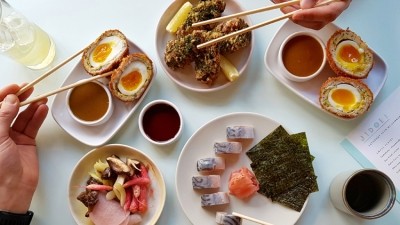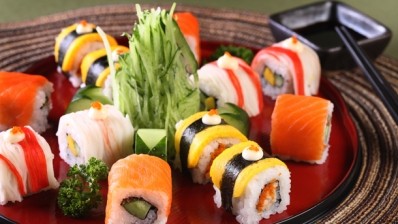Viewpoint
Brett Redman of Jidori on the Japanese cuisine explosion

Why is now the time for Japanese food, why is it so big at the moment?
I think that Asian food, I know that’s a broad term but that style of food, is fresher, it’s lighter, and it’s pretty much the polar opposite of traditional English food. I think that it’s seeing a massive rise in popularity because of those things; it’s so much more interesting, and it’s more diverse than English or European food. Plenty of people are travelling and spending a lot of time overseas, so I reckon that the majority of people in Jidori will be eating their meal and talking about when they had it in Japan.
Why did you choose to cook Japanese cuisine at Jidori?
We wanted to find a good synergy between our other restaurants, Elliots and The Richmond. They cook ingredients over a charcoal or wood grill, so finding a concept or style of cuisine that was different, but would also have equal opportunities to use good quality British produce. Natural charcoal and wood is at the core of all three of our restaurants – Elliots is meat heavy, The Richmond is seafood-focused and this one just happens to be Japanese.
There is a similar thinking behind all of the dishes at all of the restaurants, and my business partner has always wanted to do something in the Asian food market, and our head chef here shares a passion about Japanese cooking; we’ve spent a lot of time talking about both travelling across Japan, what we experienced and it all came together at the end. Originally the menu was going to be a lot more broad with different styles, and then you have to work out how you’re going to do it, so that means big kitchens, lots of chefs and lots of different ingredients, and it all became a little bit much. The philosophy of our restaurants is to keep it simple.
Is there more to Japanese food than the public currently perceives?
Yeah, definitely, even within each style there are loads of different regional variations. You see that with everything, don’t you? There’s no such thing as Mexican food, or Italian food, or Spanish food; every area, every region, every country, every style of cuisine has its own unique twists and flavours on it. It comes down to the individual aspects of that area, whether it be the climate, the produce available, or its history and how it was populated. For us it was about filling that little gap as you’ve got your super high-end Japanese restaurants in London, we didn’t want to be reaching for that kind of level but we also didn’t want to pitch ourselves too low. We think we’re in the lower-middle market where you can spend £25-£30 a head and have a really great, personalised meal in a friendly environment.
Do you think customers are seeking a winder scope of food in the Japanese food sector?
I think consumers are definitely looking at that lower-middle market that’s affordable and accessible on a daily basis. Across all of the restaurants that we do we say to each other that we want to create a menu and an environment that seems approachable and accessible, and it’s somewhere that you want to go on a Monday or a Tuesday, and you read the menu and think that’s just full of things you want to eat. Beyond that we want to have the ambition and motivation to create something that’s destination-worthy, somewhere that’s good enough to make someone want to travel across London for, so if you pitch it at the accessible, everyday level that you try to achieve, you should end up with a great product at the right price-point.
Why should more chefs turn their attention to Japanese food?
When you look at it from a chef’s perspective it’s all about a balance of flavours, quality of produce and the simplicity of flavours. If you make something you want to be able to taste what you’re making and not have it covered in heavy sauces. If they make fish they want to taste the fish. They might use some sauces and lighter seasoning on top of it to improve the taste of that core ingredient, but you’re not trying to hide it. The good thing to learn out of it is a bit of confidence in that you can strip the food back a little bit further than you would think and focus on the ingredient and the quality of the produce. If you are a chef and you want to learn to be the complete chef then it’s good to work with different cultures and different cuisines and different people.
What does the future hold for Japanese food?
I would suggest that it would go the regional variation way. You will start knowing what style of food you’re eating. People go on about ramen, so it won’t be long before people are saying ‘this is Kyoto-style ramen’ or ‘this is Tokyo-style ramen’, and hopefully with that explosion of interest you’ll start getting Japanese chefs over here. A lot of it now is Western-style chefs who have trained with Japanese chefs, so it would be great to see locally-trained Japanese chefs who have the confidence to bring their own styles to London. I hope to see people seeing the explosion in London and packing their knives up and coming here.



















